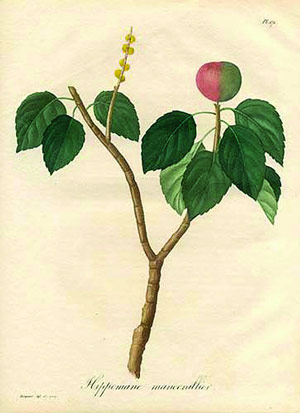The ridiculously poisonous Manchineel

Environmentalists are sometimes disparagingly called ‘tree-huggers’, but that would be a bad idea in the case of the Manchineel tree (Hippomane mancinella L., family Euphorbiaceae). In fact, any form of contact with any part of this tree is extremely dangerous due to the potent toxin in the wood, bark, leaves, and fruit.
The tree is up to 15m (50 feet) tall, with lush leaves. Its fruit looks like and tastes like apples, but the sweet flavour quickly gives way to an intensifying burning feeling that will make swallowing almost impossible. One article warned that eating enough of the fruit would cause one to “suffer about the same fate as someone exposed to nerve gas. … This tree can, and has, killed people.”1 One woman who, along with her friend, ate some of the benign-looking fruit they found on a Caribbean beach described it:

I rashly took a bite from this fruit and found it pleasantly sweet. My friend also partook (at my suggestion). Moments later we noticed a strange peppery feeling in our mouths, which gradually progressed to a burning, tearing sensation and tightness of the throat. The symptoms worsened over a couple of hours until we could barely swallow solid food because of the excruciating pain and the feeling of a huge obstructing pharyngeal lump.2
It doesn’t get better when you examine other parts of the tree. The leaves and wood contain a milky sap that can cause serious chemical burns to skin, and cause eye damage, including temporary blindness, if it gets into your eyes.3 Unfortunate people seeking shelter from the rain have become seriously injured when rain mixed with the toxic sap dripped on them while standing under the tree.

This sap is a hazard to anyone chopping down the tree, but burning it isn’t an option either. The toxic smoke that comes off the wood again causes eye irritation and possible eye damage. It is common for the tree to be marked with warning signs or red painted bands warning people to stay well away from this menace. The Guinness Book of World Records has bestowed the title of ‘the world’s deadliest tree’ on the Manchineel.4
Indigenous peoples knew of this tree’s properties and used the toxic sap to poison their arrows. Famed Spanish explorer Juan Ponce de León died in 1521 after being wounded with an arrow containing Manchineel poison.5
Why would a God of love create the Manchineel tree?
A biblical creationist can’t help asking the question, did God create the Manchineel tree, and if so, why? We can look at several possibilities. It is very likely that the Manchineel came from a created kind of plants that were not originally toxic. It is also possible that the toxins were originally produced in a much smaller quantity, and a broken gene may have caused the production to become uncontrolled. Since most fruit trees reproduce by having their fruit eaten and seeds spread, having fruit that is toxic to most creatures would not be an optimal reproduction strategy.
We can see the wonderful adaptivity that God designed in living beings, as the black-spined iguana has become immune to the poison. It has been seen in the trees and eating the fruit.5 Some crabs and birds are similarly immune to the fruit’s toxins.6

Even for humans, the tree can be useful as more than a source of arrow poison. The fruits when dried can be used as a diuretic, and Manchineel gum has various medicinal uses. The wood ceases to be poisonous when dried, and is “highly prized” in furniture making.2 So the Manchineel, though highly hazardous to human beings in this fallen world, even now has some redeeming properties.
A reminder of the other tree of death
One is easily reminded of the other ‘tree of death’, the Tree of the Knowledge of Good and Evil. Like the Manchineel, the tree had fruit that initially looked good for food, but brought death when it was eaten. Adam warned Eve not to even touch the tree, which is also good advice when it comes to the Manchineel.
When we understand how the Fall affected the world, and how some living things adapted in a post-Fall environment, it becomes easier to understand how various living things that hurt humans came about.
References and notes
- Janiskee, B., National park mystery plant 2: There’s good reason they call this thing ‘the death apple’, National Parks Traveler; nationalparkstraveler.org, 24 Apr 2009. Return to text.
- . Strickland, N., Eating a manchineel ‘beach apple’, BMJ; ncbi.nlm.nih.gov, 12 Aug 2000. Return to text.
- Pitts, J.F. et al. Manchineel keratoconjunctivitis, British J. Ophthalmology 77:284–288, 1993. Return to text.
- ‘Most dangerous tree’ guinnessworldrecords.com; 2011. Return to text.
- Menser, C., Avoid the deadly manchineel tree, Dave’s Garden; davesgarden.com, 27 Dec 2018. Return to text.
- Salamanca, E. et al., Tree of Death, Times of the Islands; timespub.tc/2017/06/tree-of-death, Summer 2017. Return to text.


Readers’ comments
Comments are automatically closed 14 days after publication.